HEAL Committee Report
If you have any questions or comments regarding the accessibility of this publication, please contact us at accessible@parl.gc.ca.
FIRST NATIONS AND INUIT DENTAL HEALTH
When the Standing Committee on Health became aware of concerns about dental care provided through Health Canada’s Non-Insured Health Benefits (NIHB) program, it decided to undertake a short study. Initially, this undertaking was to examine access by First Nations and Inuit individuals to preventive and restorative services. However, during the proceedings, the Committee also heard related problems surrounding client consent.
To gain clearer knowledge about the multiple issues, the Committee arranged one meeting with Health Canada and various organizations representing the involved interests. The meeting included witnesses from the Assembly of First Nations (AFN), Inuit Tapiriit Kanatami (ITK), Canadian Dental Association (CDA), and Canadian Dental Hygienists Association (CDHA).
THE NON-INSURED HEALTH BENEFITS DENTAL PROGRAM
A. Overview of the Dental Program
Health Canada told the Committee that, through the Non-Insured Health Benefits (NIHB) program, it provides specified dental services to approximately 720,000 registered First Nations, Inuit and Innu individuals. In general, coverage for dental services is based on individual need and includes:
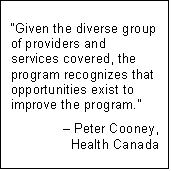
| • | Diagnostic (examinations, x-rays) |
| • | Preventive (cleanings) |
| • | Restorative (fillings) |
| • | Endodontic (root canal treatments) |
| • | Periodontic (treatment of gums) |
| • | Prosthodontics (removable dentures and fixed bridges) |
| • | Oral surgery (removing teeth) |
| • | Orthodontics (straightening teeth) |
| • | Adjunctive services (additional like sedation). |
In 2002/2003, the NIHB dental program funded an estimated 365,000 First Nations and Inuit clients at a cost of approximately $130 million. This represented an expenditure increase of 5% from the previous year. Dental expenditures accounted for about one-fifth of the total costs of the NIHB.
B. Previous Concerns about the Dental Program
Without providing details, Health Canada referred several times to public calls for audits and increased accountability for the public funds dispensed through this program. The Committee understood that these references pointed to various concerns highlighted in reports of the Auditor General of Canada. In 1993, 1997 and 2000, the Auditor General made recommendations for improved program management and delivery in the Non-Insured Health Benefits program.
Specifically, on the dental program, the reports included the following observations:
| • | 1993 — The claims processing systems and departmental procedures are inadequate for monitoring and controlling some benefit claim payments.1 |
| • | 1997 — Dental care providers provide services up to the established frequencies and limits rather than based on needs, resulting in over-servicing of some clients. Audits of providers and a system of predetermining dental benefits has the potential to achieve savings while implementing a needs-based approach to ensure receipt of required dental care.2 |
| • | 2000 — Concerns about over-servicing by dental care providers led to a predetermination process whereby prior approval and a treatment plan for performing dental services above a prescribed dollar threshold was required. This move to predetermination was implemented nationally in late 1997 as a needs-based approach to providing dental care. Predetermination, combined with changes to the benefit schedule, reduced dental costs and program costs.3 |
C. Current Dental Plan Conditions
Health Canada indicated that it now assesses individual client needs through a predetermination process under which the dental practitioner completes a treatment plan for the recipient and submits it to the program for funding approval. The department maintains that the needs-based approach to the provision of dental benefits ensures that the client receives required services. A dental benefit grid that sets out frequency limitations for various services is also a component of the dental benefit plan.
Under the NIHB dental plan, the First Nations or Inuit client does not pay the provider directly and then seek reimbursement from the NIHB program. Instead, the provider is responsible for billing the plan in order to receive payment. Health Canada reported that the plan is moving toward electronic transfer of claims statements directly from the dental office to the claims processor. Alberta is expected to be online in the spring of 2003 and it will be followed soon after by national access for providers in all provinces and territories.
Currently, each registered client is entitled to receive dental work up to a pre-established amount of $800 every 12 months without any prior approval. This pre-determination level was increased from $600 as recently as October 2002. Health Canada indicated that the average patient receives about $420 worth of care annually.
![Text Box: “[trans] The predetermination level should be raised to $1,000, as with most standard programs on the market.”
– Dr. Louis Dubé,
CDA](/Content/Committee/372/HEAL/Reports/RP1032306/healrp05/graphics/08-rap-2-e.gif)
For payment on other work beyond the pre-established amount of $800, the dentist is required to provide particular documentation. While specific emergency procedures above this amount do not require predetermination, plan administrators expect predetermination for certain procedures such as root canals, crowns and dentures. However, post approvals are considered for certain basic and emergency services when the intervention is deemed necessary. Thus, post-approval of services that are appropriate and required can take place and be reimbursed through the NIHB plan.
Information from Health Canada pointed out that dentists in private practice are the primary providers of dental care under the NIHB dental program. Fee-for-service dental costs represented 84.9% of all NIHB dental costs in 2001/2002. Health Canada also utilized contract dentists who accounted for 4.2% of total costs.4
Health Canada noted that dental hygienists provide care to clients within dental practices but not independently. The department also employs First Nations and Inuit dental therapists who are trained over two years at the National School of Dental Therapy in Prince Albert, Saskatchewan. After training, these dental therapists generally return to live and work in their communities.
Expenditure data for 2001/2002 reveals that recall examinations were performed most often and porcelain/ceramic fused metal crowns were the most costly dental procedure. Utilization data indicates that 36% of eligible clients received at least one dental procedure. Of these, 55% were female and 45% male. The average age of the dental claimants was 27 years.
The Committee heard that, although dental and oral diseases are largely preventable, First Nations and Inuit people have dental decay rates from two to five times greater than the non-Aboriginal population in Canada. This is a particular concern for young people with indications that the average 12-year old First Nations or Inuit child may have between seven to nine teeth missing, filled or decayed compared to one in other Canadian children the same age. Much of this problem starts with early childhood tooth decay, experienced by an estimated 72% of First Nations and Inuit children aged two to five years. An additional worry is the link of gum diseases with cardiovascular diseases and with adverse pregnancy outcomes such as low birth weight babies and pre-term deliveries.
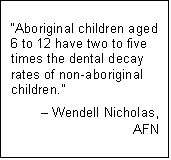
Witnesses emphasized the importance of good oral health to self-esteem as well as for the routine functions of daily living such as eating, communications and socializing. They noted that poor dental health among First Nations and Inuit children leads to significantly increased costs for medical travel and treatment involving surgery under general anaesthetic. If left untreated, oral disease can lead to infection, pain, inability to concentrate in school, trouble sleeping, difficulties with digestion, behavioural and social problems.
The Committee learned about numerous factors that may lead to poor oral health and dental decay. Witnesses pointed out the link to dietary changes and called for support for traditional dietary practices and for improved food access in remote areas. They noted the lack of access to clean potable water with fluoridation in many communities and mentioned the link between smoking and periodontal disease. Finally, witnesses indicated that there are numerous impediments to accessing oral health prevention and treatment services ranging from a lack of providers to culturally based client concerns.
The Committee is cognizant of Health Canada’s ongoing efforts to improve the dental health of First Nations and Inuit clients. It supports the effort to develop and implement a comprehensive and coordinated oral health initiative. However, it feels that the current approach focusing on pathologies and treatments must be transformed more quickly to one focusing on wellness and prevention.
The Committee took particular note of the numerous references to the need to achieve and maintain oral health. It agreed that there must be a clear definition of the desired oral health standard with specific objectives and targets. It supports oral health programs that will produce measurable and positive results. In particular, it wants an increase in the number of First Nations and Inuit clients accessing preventive care and a decrease in the amount of tooth decay among children. To accomplish such outcomes, it calls on Health Canada to establish an effective and accountable oral health strategy in collaboration with First Nations and Inuit clients.
RECOMMENDATION 1: EFFECTIVE AND ACCOUNTABLE ORAL HEALTH STRATEGY
The Committee recommends that Health Canada:
| (a) | Undertake a new approach to oral health based on a wellness model that gives priority to promotion and prevention strategies; |
| (b) | Develop and implement an oral health strategy with measurable goals that will investigate alternative delivery systems aimed at improving oral health and access to services; |
| (c) | Initiate results-based incentives for all participants, clients and providers, to increase access to and positive outcomes from prevention measures; and, |
| (d) | Increase the ability to monitor oral health trends to ascertain if the resource allocations are effective and the program is accountable. |
RECOMMENDATION 2: COLLABORATION WITH FIRST NATIONS AND INUIT CLIENTS
The Committee recommends that Health Canada work with First Nations and Inuit clients to:
| (a) | Improve public education and awareness of oral health as a key element of overall well-being; |
| (b) | Build oral health links into existing programs with a health education and promotion focus such as the First Nations Headstart On-reserve and the Canada Prenatal Nutrition Program; |
| (c) | Assist communities in monitoring and reporting on oral health initiatives; |
| (d) | Initiate community-directed and results-based incentives for preventive oral health, including such elements as community recognition campaigns and dental hygiene or dentistry scholarships; |
| (e) | Communicate the availability of necessary preventive (and restorative) measures for every child and adult; and, |
| (f) | Develop more creative and culturally appropriate models for delivering preventive (and restorative) care. |
The Committee was told that only about 36 to 38% of NIHB clients see a dentist once a year compared to 75% for other Canadians. They also pointed to data indicating that women and young adults were more likely to seek care. Of the almost half of respondents who needed dental care, most needed restoration such as fillings and crowns, maintenance such as check-ups and cleaning, prosthetic work such as dentures.
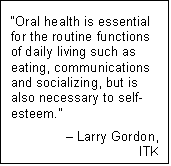
Witnesses suggested several reasons for limited client access to dental care. For example, they noted that many clients live in geographically remote areas where there is no dentist in residence. Many northern towns have trouble attracting and retaining new dentists on a permanent basis. In addition, clients may not have access to the preventive and treatment services offered by dental hygienists. The NIHB program does not allow dental hygienists to be on the list of providers with a billing number even in provinces where dental hygienists can practise independently from dentists. Others indicated that the current medical transportation policy might, in some regions, lead to a reduction in client access to dental treatment.
From the provider perspective, witnesses indicated that existing dentists are opting out of the NIHB program due to heavy administrative requirements for predeterminations and for minor revisions to treatment plans. They noted the lengthy waits for approval when X-rays are sent to Ottawa by mail. They called for the ability to send pre-approvals or other information electronically. Dentists pointed particularly to additional requirements and differences from standard plans that required specially trained staff to deal with the extra paperwork. They worried about assuming a financial risk if Health Canada denies payment after the procedure has been done.
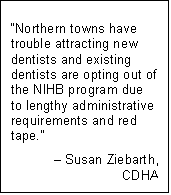
The Committee acknowledges that Health Canada recently increased to $800 the client entitlement for dental work every 12 months without any prior approval. It feels however that this pre-established amount could limit the ability to undertake appropriate and necessary preventive and restorative work. It also noted that providers and clients appeared unaware of the fact that dentists are covered for the performance of work done without prior approval if it is deemed essential. In addition, it is supportive of the preventive efforts of dental hygienists and would like to see an expanded role for them under the NIHB dental program.
The Committee is particularly anxious to remove impediments that currently limit the movement to improved oral health and to appropriate access to dental care. While it supports the efforts to train dental therapists for First Nations and Inuit communities, it also wants to ensure that First Nations and Inuit individuals can enter established fields of dentistry. In addition, it seeks reassurance that Health Canada will address the administrative problems and concerns about medical transportation.
RECOMMENDATION 3: IMPROVED ACCESS TO COMPREHENSIVE DENTAL CARE
The Committee recommends that Health Canada:
| (a) | Outside of the pre-established amount for services provided without prior approval, establish and promote a regular prevention plan for every First Nation and Inuit client under 25 years of age to allow on a routine annual basis a prescribed number of preventive interventions such as dental cleanings and sealants, fluoridation; instruction and education sessions, etc.; |
| (b) | Increase the pre-established amount for services provided without prior approval to $1,000 while continuing to monitor for appropriateness of services provided; |
| (c) | Permit and facilitate a more independent role for dental hygienists; for example, allow them to bill directly up to a predetermined amount of $200 per client annually; and, |
| (d) | Adhere to the same standards and frequency limitations as those established with dental insurance plans for other Canadians and inform clients that the approach and limitations are applicable to other populations. |
RECOMMENDATION 4: IMPROVED ACCESS TO DENTAL CARE PROVIDERS
The Committee recommends that Health Canada:
| (a) | Work closely with relevant universities and colleges on appropriate measures, including directed scholarships, aimed at increasing the number of First Nations and Inuit dentists and dental hygienists; |
| (b) | Ensure that the medical transportation policy facilitates and enables access to dental treatment; and, |
| (c) | Reduce the administrative burden for providers while ensuring accountability. |
When the Committee became aware of concerns about the NIHB dental health program, it did not know about the problems associated with the consent forms that must be completed by First Nations and Inuit clients. After hearing the frequency and intensity of witness testimony on this matter, it was convinced that the requirement for consent as a condition of dental benefit coverage must be addressed as part of this oral health study.
![Text Box: “We have always worked, in the past, with implicit consent from our clients, but based on advice from the Department of Justice, we began working on a plan to begin to collect the [written] consent from our clients.”
– Leslie MacLean,
Health Canada](/Content/Committee/372/HEAL/Reports/RP1032306/healrp05/graphics/08-rap-6-e.gif)
The Committee learned that the NIHB program has now developed a single consent form to cover all the non-insured health benefits, namely: drugs, medical transportation, dental, medical supplies and equipment, vision, crisis intervention counselling and provincial health care premiums. Health Canada explained that this ‘blanket consent’ is intended to reduce the paper burden and the bureaucracy while reducing misuse of the program. Health Canada emphasized that the consent initiative respects the privacy rights of the clients and indicated that benefits will not be denied to clients should they refuse to sign the new consent form. The Committee was told that clients still retain the right to apply for reimbursement on a per-use basis by submitting a ‘NIHB Client Reimbursement Request Form’.
However, other witnesses suggested that a ‘blanket consent’ covering all benefit areas is inappropriate and culturally insensitive. Witnesses testified that the consent is too broad and leaves the impression with clients that other departments, organizations or individuals will have unrestricted use of their personal information. In particular, they noted a previous breach of trust by the First Nations and Inuit Health Branch that resulted in the violation of access and privacy surrounding the collection, use and disclosure of personal health information of First Nations and Inuit peoples. The Committee heard from some providers that the consent might also conflict with existing provincial privacy laws.
The Committee appreciates Health Canada’s attempts to improve the NIHB program while balancing fair and complete benefits to First Nations and Inuit peoples with accountability to the Canadian public. It understands the need to make the administration and delivery of the program more efficient and accountable. It acknowledges that the new single NIHB client consent approach appears to be more efficient.
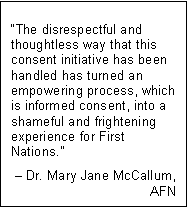
However, the Committee is sympathetic to the arguments forwarded by First Nations and Inuit clients as well as the providers. It agrees that the new consent was not introduced in the most effective or accommodating manner. Witnesses suggested that, if the new consent is introduced over a period of just one year, many clients who do not access the NIHB program in that period may be overlooked. In order to better accommodate the cultural diversity, witnesses felt that the consent should have been introduced more gradually but more actively and directly in specific communities. Some suggested that the introduction of the consent initiative should include the direct involvement of program employees, with appropriate translators, to explain the new consent and provide an opportunity for questions. This explanation must include a clarification of who would have access to client information and who would not.
RECOMMENDATION 5: CLIENT CONSENT
The Committee recommends that Health Canada:
| (a) | Introduce another option of a one-time client consent for each of the separate benefits categories; |
| (b) | Restrict and clarify the permission for use of information acquired with consent; specify who will have access to client information and clearly state that no one else will; |
| (c) | Adhere to the same standards as dental insurance consent forms for other Canadians and ensure that clients are aware that the approach is applied to other populations; |
| (d) | Extend the deadline for introducing the new consent beyond 1 September 2003; |
| (e) | Indicate clearly to clients and providers that access to program benefits is still available even if the blanket consent form is not signed; |
| (f) | Invest in appropriate promotion of the consent initiative through improved communication with First Nations and Inuit people on a community-by-community basis about the rationale for and uses of any client consent form; and, |
| (g) | Ensure that the client consent form is available in all necessary languages and dialects. |
| 1 | Auditor General of Canada, Chapter 19 — Department of National Health and Welfare, Non-Insured Health Benefits, Ottawa: 1993, paragraphs 19.29 to19.33. |
| 2 | Auditor General of Canada, Chapter 13 — Health Canada — First Nations Health, Ottawa: 1997, paragraphs 13.124 to 13.140. |
| 3 | Auditor General of Canada, Chapter 15 — Health Canada — First Nations Health: Follow-up, Ottawa: 2000, paragraphs 15.90 and 15.91. |
| 4 | Health Canada, Non-insured Health Benefits Program 2001/2002 Annual Report, Ottawa: 2003. |